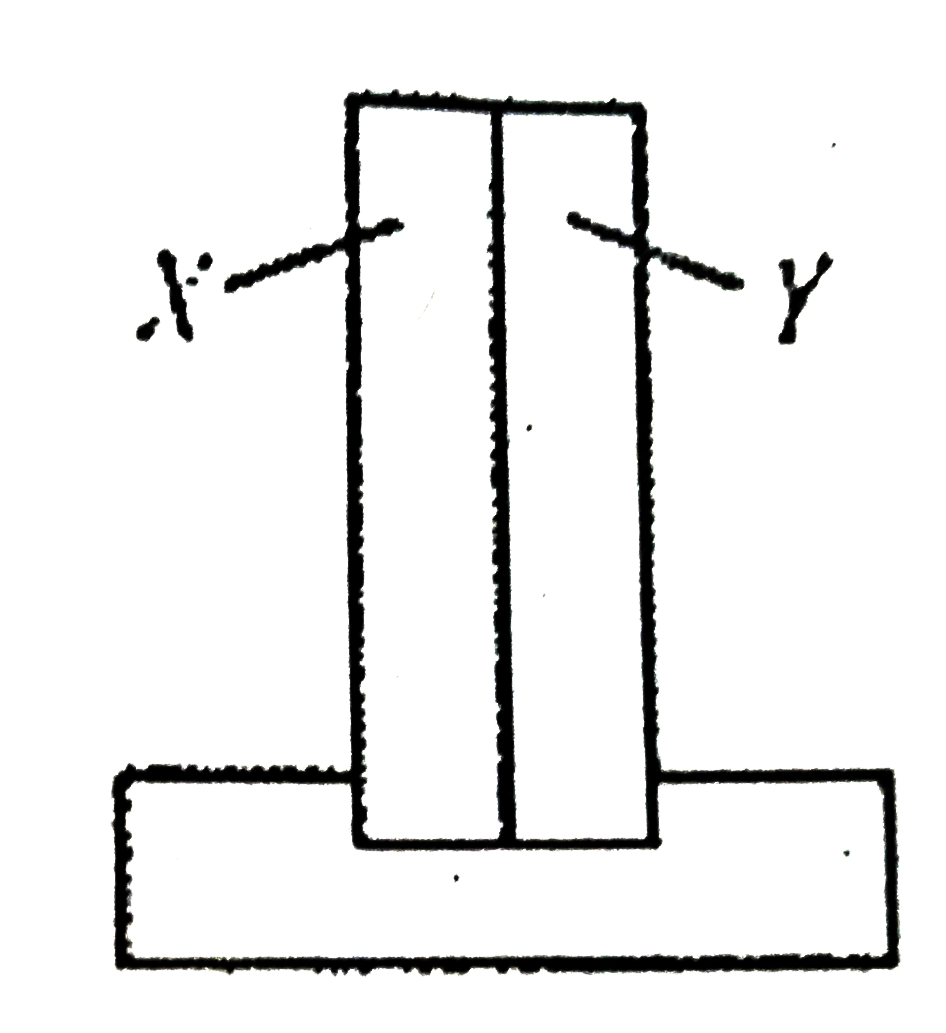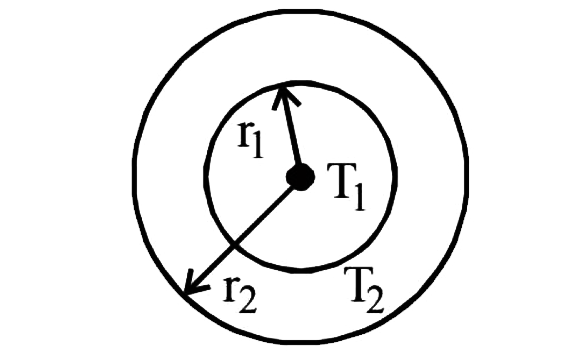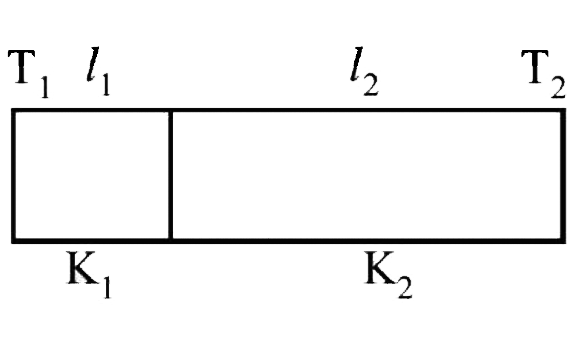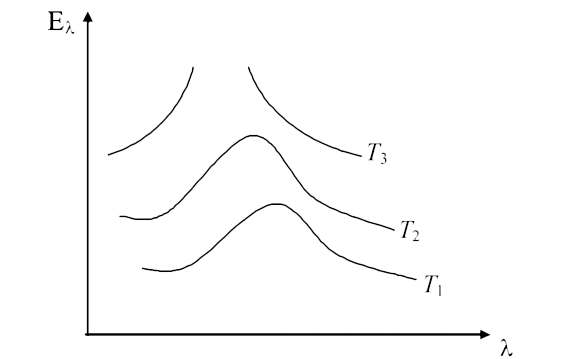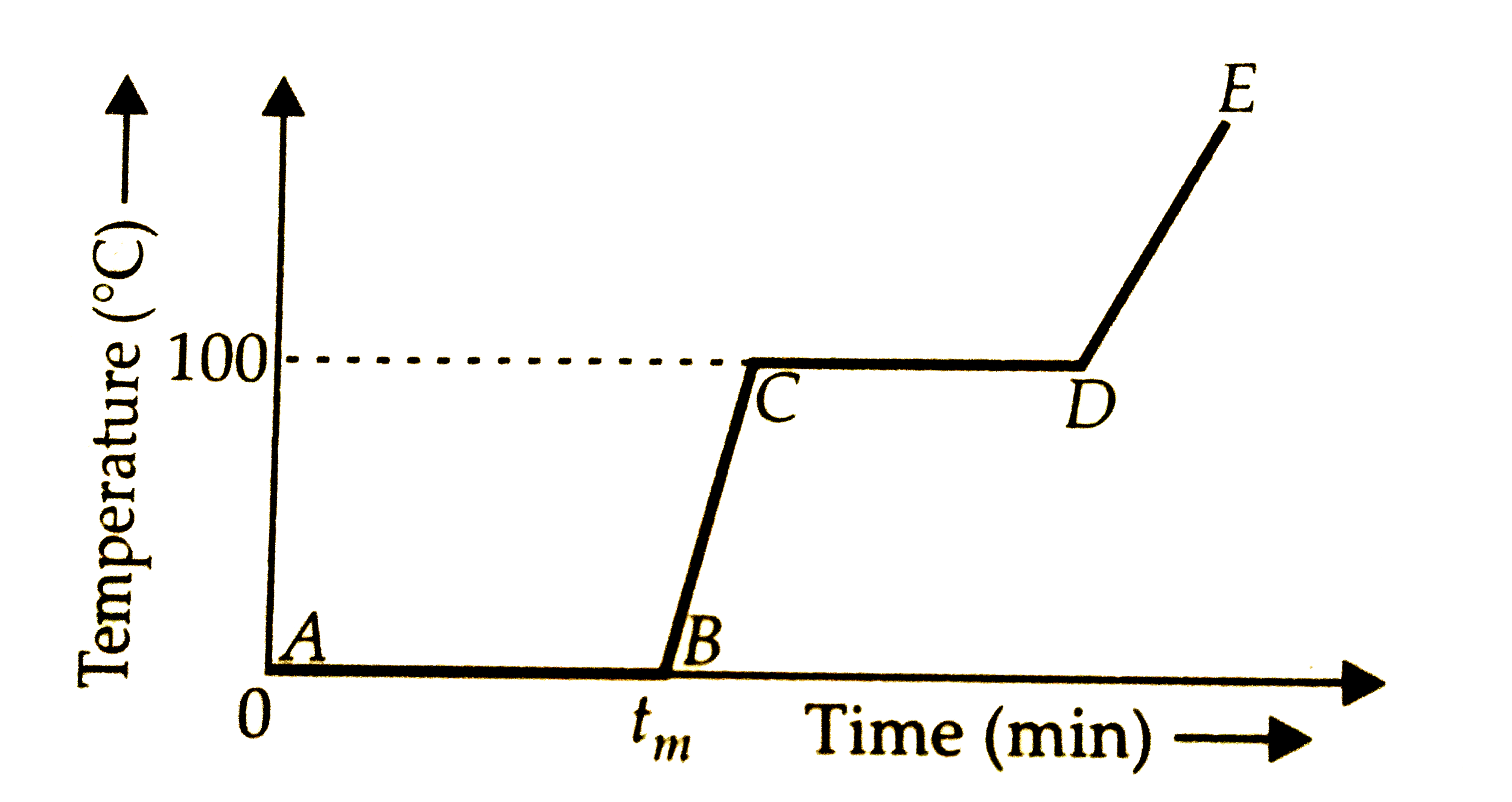COMPETITION FILE (INTEGER TYPE QUESTION ) from MODERN PUBLISHERS PHYSICS (HINGLISH) THERMAL PROPERTIES OF MATTER for Class 11
| Class 11 | PHYSICS |
| Chapter | THERMAL PROPERTIES OF MATTER |
| MODERN PUBLISHERS PHYSICS (HINGLISH) | COMPETITION FILE (INTEGER TYPE QUESTION ) |
| Medium | English |
| Academic Year | 2023-2024 |
Question 1
When a piece of metal floats in mercury at T∘C, a fraction f1 of its volume is submerged. If their temperature is increased by ΔT∘C , fraction f2 of metal piece is seen to be submerged. If the coefficients of volume expansion of the metal and the mercury are γ1 and γ2 , respectively, then the ratio f1/f2 is View SolutionQuestion 5
A uniform metal rod of length 1 and mass m is rotating with an angular velocity of magnitude o about an axis passing through its centre and perpendicular to the rod. If the temperature of the rod increases by T∘C , then change in its magnitude of angular velocity varies directly withView SolutionQuestion 14
Two metallic spheres A and B are made up of same material and also have identical surfaces. Both spheres are heated to same temperature and are then placed in a chamber which is at a lower temperature, thermally insulated from each other. If ratio of masses of A and B is 3:1, then the ratio of their initial rate of cooling isView SolutionQuestion 19
A metallic cylinder of radius R is made of a material of thermal conductivity K1 . It is surrounded by cylindrical sheet of inner radius R and outer radius 15 R, made of another metal of conductivity K2 . Two ends of the combined system are maintained at different temperature as shown in the figure. If there is no loss of heat and the system is in steady state, then the effective thermal conductivity of the system is
 View Solution
View SolutionQuestion 25
A deep rectangular pond of surface area A, containing water (density = ρ ), specific heat capacity = s), is located in a region where the outside air temperature is at a steady value of −26∘C . The thickness of the frozen ice layer in this pond, at a certain instant is x. Taking the thermal conductivity of ice as K, and its specific latent heat of fusion as L, the rate of increase of the thickness of ice layer, at this instant, would be given by View SolutionQuestion 29
A slab of stone of area of 0.36m2 and thickness 0.1m is exposed on the lower surface to steam at 100∘C. A block of ice at 0∘C rests on the upper surface of the slab. In one hour 4.8kg of ice is melted. The thermal conductivity of slab is
(Given latent heat of fusion of ice =3.63×105Jkg−1)View SolutionQuestion 41
A wooden wheel of radius R is made of two semicircular part . The two parts are held together by a ring made of a metal strip of cross sectional area S and length L. L is slightly less than 2πR. To fit the ring on the wheel, it is heated so that its temperature rises by ΔTand it just steps over the wheel. As it cools down to surrounding temperature, it process the semicircle parts together. If the coefficient of linear expansion of the metal is α, and it Young's modulus is Y, the force that one part of the wheel applies on the other part is :
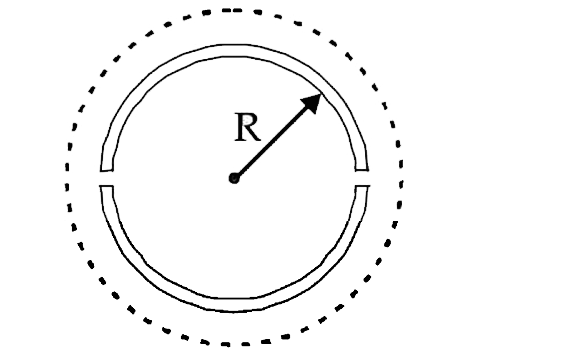 View Solution
View SolutionQuestion 46
Three rods of Copper, Brass and Steel are welded together to from a Y shaped structure. Area of cross-section of each rod =4cm2. End of copper rod is maintained at 100∘C where as ends of brass and steel are kept at 0∘C. Lengths of the copper, brass and steel rods are 46, 13 and 12 cm respectively. The rods are thermally insulated from surroundings excepts at ends. Thermal conductivities of copper, brass and steel are 0.92, 0.26 and 0.12 CGS units respectively. Rate of heat flow through copper rod is : View SolutionQuestion 52
black colored solid sphere of radius "R" and mass "M" is inside a cavity with vacuum inside.The walls of the cavity are maintained at temperature T0 .The initial temperature of the sphere is 3T0 .If the specific heat of the material of the sphere varies as αT3 per unit mass with the temperature of the sphere,where α is a constant,then the time taken for the sphere to cool down to temperature 2T0 will be ( σ Stefan Boltzmann constant) View SolutionQuestion 53
A simple pendulum made of bob of mass m and a metallic wire of negligible mass has time period 2s at T=0∘C. If the temperature of the wire is increased and the corresponding change in its time period is plotted against its temperature, the resulting graph is a line of slope S. If the coefficient of linear expansion of metal is α then value of S is :View SolutionQuestion 54
A compressive force, F is applied at the two ends of a long thin steel rod. It is heated, simultaneously, such that its temeprature increass by ΔT. The net change in its length is zero. Let l be the length of the rod, A its area of cross-section, Y its Young's modulus, and α its coefficient of linear expansion. Then, F is equal to View SolutionQuestion 55
A steel rail of length 5 m and area of cross section 40cm2 is prevented from expanding along its length while the temperature rises by 10∘C . If coefficient of linear expansion and Young's modulus of steel are 1.2×105K1 and 2×1011Nm2 respectively, the force developed in the rail is approximately:View SolutionQuestion 56
In an experiment a sphere of aluminium of mass 0.20 kg is heated upto 150∘C. Immediately, it is put into water of volume 150 cc at 27∘C kept in a calorimeter of water equivalent to 0.025 kg. Final temperature of the system is 40∘C. The specific heat of aluminium is (take 4.2 Joule = 1 calorie)View SolutionQuestion 57
A copper ball of mass 100 gm is at a temperature T. It is dropped in a copper calorimeter of mass 100 gm, filled with 170 gm of water at room temperature. Subsequently, the temperature of the system is found to be 75∘C . T is given by : (Given : room temperature = 30∘C, specific heat of copper =0.1cal/gm∘C)View SolutionQuestion 61
A metal rod AB of length 10x has its one end A in ice at 0∘C, and the other end B in water at 100∘C. If a point P one the rod is maintained at 400∘C, then it is found that equal amounts of water and ice evaporate and melt per unit time. The latent heat of evaporation of water is 540cal/g and latent heat of melting of ice is 80cal/g. If the point P is at a distance of λx from the ice end A, find the value λ. [Neglect any heat loss to the surrounding.] View SolutionQuestion 62
Two rectangular blocks, having identical dimensions, an be arranged either in configuration-I or in configuration-II as shown in the figure. One of the blocks has thermal conductivity k and the other 2k. The temperature difference between the ends along the x-axis is the same in both the configurations. It takes 9s to transport a certain amount of heat from the hot end to the cold end in the configuration-I. The time to transport the same amount of heat in the configuration-II is
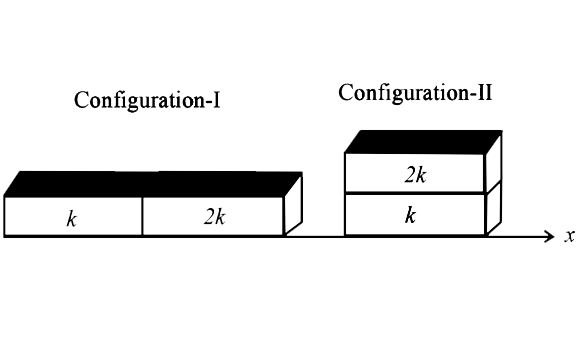 View Solution
View SolutionQuestion 63
Parallel rays of light of intensity I=912WM−2 are incident on a spherical black body kept in surroundings of temperature 300K. Take Stefan-Boltzmann constant σ=5.7×10−8
Wm−2K−4 and assume that the energy exchange with the surroundings is only through radiation. The final steady state temperature of the black body is close to View SolutionQuestion 64
The ends Q and R of two thin wires, PQ and RS, are soldered (joined) together. Initially each of the of wire has a length of 1m at 10∘C. Now the end P is maintained at 10∘C, while the ends S is heated and maintained at 400∘C. The system is thermally insultated from its surroundings. If the thermal conductivity of wire PQ is twice that of the wire RS and the coefficient of linear thermal expansion of PQ is 1.2×10−5K−1, the change in length of the wire PQ is View SolutionQuestion 65
A water cooler of storages capacity 120 liters can cool water at a constant rate of P watts. In a closed circulation system (as shown schematically in the figure), the water from the cooler is used to cool an external device that generates constantly 3kW of heat (thermal load). The temperature of water fed into the device cannot exceed 30∘C and the entire stored 120 liters of water is initially cooled to 10∘C. The entire system is thermally insulated. The minimum value of P ( in watts) for which the device can be operated for 3hours is
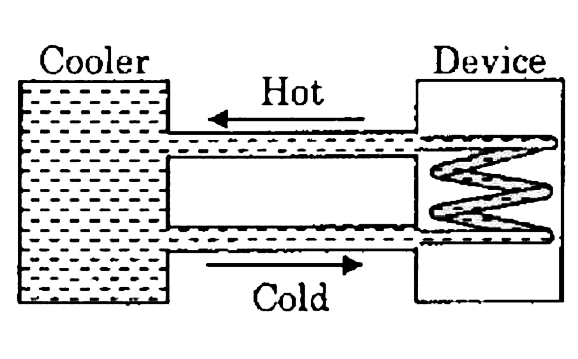
(Specific heat of water is 4.2kJkg−1K−1 and the density of water is 1000kgm−3)View SolutionQuestion 66
A current carrying wire heats a metal rod. The wire provides a constant power P to the rod. The metal rod is enclosed in an insulated container. It is observed that the temperature (T) in the metal rod change with the (t) as T(t)=T0(1+βt1/4) where β is a constant with appropriate dimension of temperature. the heat capacity of metal is :View SolutionQuestion 69
Two bodies A and B having equal outer surface areas have thermal emissivity 0.04 and 0.64 respectively. They emit total radiant power at the same rate. The difference between wavelength corresponding to maximum spectral radiance in the radiation from B and that from A is 2μm . If the temperature of A is 6000 K, then View SolutionQuestion 71
A composite block is made of slabs A, B, C, D and E of different thermal conductivities (given in terms of a constant K) and sizes (given in terms of length L) as shown in the figure. All slabs are of same width. Heat 'Q'flows only from left to right through the blocks.

Then in steady state View SolutionQuestion 72
A bimetallic strip is composed of two identical strips, one of steel and other of brass. When the temperature of the strip is raised by ΔT , it bends to form arc of curvature R. If the coefficients of linear expansion of steel and brass are α1 and α2 , respectively, then R is View SolutionQuestion 77
A human body has a surface area of approximately 1 m2. The normal body temperature is 10 K above the surrounding room temperature T0. Take the room temperature to be T0=300K. For T0=300K, the value of σT40=460Wm−2 (where σ is the Stefan-Boltzmann constant). Which of the following options is/are correct?View SolutionQuestion 78
A rod of length 50 cm is made of metal A and elongates by 0.2 cm when it is heated from 0∘C to 100∘C . Another rod made of metal B is of length 60 cm and elongates by 0.18 cm when heated from 0∘C to 100∘C . A composite rod of length 80 cm is made by welding pieces of rods A and B, placed end to end. When metal C is heated from 0∘C to 50∘C , it gets elongated by 0.08 cm.
What is the ratio of linear expansion of metal A and metal B?View SolutionQuestion 79
A rod of length 50 cm is made of metal A and elongates by 0.2 cm when it is heated from 0∘C to 100∘C . Another rod made of metal B is of length 60 cm and elongates by 0.18 cm when heated from 0∘C to 100∘C . A composite rod of length 80 cm is made by welding pieces of rods A and B, placed end to end. When metal C is heated from 0∘C to 50∘C , it gets elongated by 0.08 cm.
The length of the rod of metal A in the composite rod is View SolutionQuestion 80
A rod of length 50 cm is made of metal A and elongates by 0.2 cm when it is heated from 0∘C to 100∘C . Another rod made of metal B is of length 60 cm and elongates by 0.18 cm when heated from 0∘C to 100∘C . A composite rod of length 80 cm is made by welding pieces of rods A and B, placed end to end. When metal C is heated from 0∘C to 50∘C , it gets elongated by 0.08 cm.
The length of the rod of metal B in the composite rod is View SolutionQuestion 81
Heat energy of 10,000 J is supplied to a metal block of mass 600 g at atmospheric pressure. The initial temperature of the block is 20∘C, specific heat of metal =300Jkg−1C−1 , relative density of metal = 7.0, coefficient of volume expansion of metal =6×10−5∘C−1 and atmospheric pressure, P=105 Pa. Also, Heat energy supplied = mass x specific heat x change in temperature
The final temperature of the block isView SolutionQuestion 82
Heat energy of 10,000 J is supplied to a metal block of mass 600 g at atmospheric pressure. The initial temperature of the block is 20∘C, specific heat of metal =300Jkg−1C−1 , relative density of metal = 7.0, coefficient of volume expansion of metal =6×10−5∘C−1 and atmospheric pressure, P=105 Pa. Also, Heat energy supplied = mass x specific heat x change in temperature
The amount of work done by the block on the surroundings where ΔW=PΔV is View SolutionQuestion 83
Heat energy of 10,000 J is supplied to a metal block of mass 600 g at atmospheric pressure. The initial temperature of the block is 20∘C, specific heat of metal =300Jkg−1C−1 , relative density of metal = 7.0, coefficient of volume expansion of metal =6×10−5∘C−1 and atmospheric pressure, P=105 Pa. Also, Heat energy supplied = mass x specific heat x change in temperature
Find the change in internal energy if it is calculated as heat energy supplied minus the work done by the block on surroundings. View SolutionQuestion 84
The spectra of all stars show a continuous spectrum like the solar spectrum, in which dark absorption lines are superimposed. The photosphere (inner layer of the star) emits radiations of all wavelengths, producing a continuous spectrum. On passing through the outer (comparatively cooler) layer of the star, radiations of certain wavelengths are selectively absorbed by this layer. This is the cause behind the dark lines in the star's spectrum. These dark lines are characteristics of the substances present in the outer layer of the star. For measuring the surface temperature of the star, we need to measure the wavelength at which the intensity of emitted radiation is maximum and then using Wien's displacement law, given below
λm=T=b where b is the Wien's constant and its experimentally determined value is 2.89×10−3mK
Which of the following options is true for spectrum of light received from a star?View SolutionQuestion 85
The spectra of all stars show a continuous spectrum like the solar spectrum, in which dark absorption lines are superimposed. The photosphere (inner layer of the star) emits radiations of all wavelengths, producing a continuous spectrum. On passing through the outer (comparatively cooler) layer of the star, radiations of certain wavelengths are selectively absorbed by this layer. This is the cause behind the dark lines in the star's spectrum. These dark lines are characteristics of the substances present in the outer layer of the star. For measuring the surface temperature of the star, we need to measure the wavelength at which the intensity of emitted radiation is maximum and then using Wien's displacement law, given below
λm=T=b where b is the Wien's constant and its experimentally determined value is 2.89×10−3mK
The factor on which the colour of a star depends isView SolutionQuestion 86
The spectra of all stars show a continuous spectrum like the solar spectrum, in which dark absorption lines are superimposed. The photosphere (inner layer of the star) emits radiations of all wavelengths, producing a continuous spectrum. On passing through the outer (comparatively cooler) layer of the star, radiations of certain wavelengths are selectively absorbed by this layer. This is the cause behind the dark lines in the star's spectrum. These dark lines are characteristics of the substances present in the outer layer of the star. For measuring the surface temperature of the star, we need to measure the wavelength at which the intensity of emitted radiation is maximum and then using Wien's displacement law, given below
λm=T=b where b is the Wien's constant and its experimentally determined value is 2.89×10−3mK
The study of dark lines in the spectrum of a star shows that the atmosphere of stars containView SolutionQuestion 97
Each question contains statements given in two columns, which have to be matched. Statements in column I are labelled as A, B, C and D, whereas statements in column II are labelled as p, q, r and s. Match the entries of column I with appropriate entries of column II. Each entry in column I may have one or more than one correct option from column II. The answers to these questions have to be appropriately bubbled as illustrated in the given example. If the correct matches are A → (q, r), B →(p, s), C →( r, s) and D → (q), then correctly bubbled matrix will look like the following:

 View Solution
View SolutionQuestion 98
Each question contains statements given in two columns, which have to be matched. Statements in column I are labelled as A, B, C and D, whereas statements in column II are labelled as p, q, r and s. Match the entries of column I with appropriate entries of column II. Each entry in column I may have one or more than one correct option from column II. The answers to these questions have to be appropriately bubbled as illustrated in the given example. If the correct matches are A → (q, r), B →(p, s), C →( r, s) and D → (q), then correctly bubbled matrix will look like the following:

 View Solution
View SolutionQuestion 99
A copper wire of length l and radius 2 mm is suspended from a fixed support vertically and a mass m is hung from its other end. The wire initially at 30∘C is cooled down to 20∘C to bring it back to its original length l . The coefficient of linear thermal expansion of the copper is 1.7×10−5'∘C−1 . If l >> the diameter of wire,then find the value of m/5 in kg close to nearest integer. Take, g=10m/s2,Y=1.1×1011N/m2View SolutionQuestion 100
A brass boiler of base area 0.10m2 and thickness 1.0 boils water at the rate of 5.0kgmin−1 when placed on a stove. The thermal conductivity of brass is 109Js−1m−1∘C−1 and heat of vaporisation of water is 2256Jg−1 . If the temperature of the part of the flame in contact with the boiler is T=3p2q5r11s109 , then find the value of p+q+r+s.View SolutionQuestion 101
A feverish person is running a temperature of 101∘F and is given paracetamol to lower his temperature. Due to medicine, there is an increase in rate of evaporation of sweat from his body. The mass of the person is 50 kg and the specific heat of human body is approximately about 1calg−1∘C−1 . If the fever is brought down to 98∘F in 25 mins, the average rate of extra evaporation caused by the medicine is R in g min−1 , then the value of 87R/100 is (Latent heat of water at that temperature=580 g/cal)View SolutionQuestion 102
A heater of resistance 20 Ω is used to heat a room at 10∘C and is connected to 220 V mains. The temperature is uniform inside the room and heat is transmitted outside the room through a glass window of area 1.2m2 and thickness 0.1 cm. If T∘C is the temperature outside and thermal conductivity of glass is0.2cals−1m−1∘C−1 , then find the value of 10T - 75 close to nearest integer.View SolutionQuestion 103
A sphere of diameter 6 cm and mass 250 g is floating in a beaker containing a liquid. When the temperature is raised, the sphere just begins to sink at a temperature of 30∘C . The density of the liquid at 0∘C is 2.92g/cm3 . If the expansion of the sphere is ignored, the coefficient of cubical expansion of the sphere is γ , then 109γ13837=2a3b11c . Compute the value of abc View SolutionQuestion 104
A brass wire is 2.0 m long at 40.02∘C and is held taut with a little tension between the two rigid supports. The wire is now cooled down to −47.5∘C. If the tension developed in the wire is now T and the radius of the wire is 1.0 mm, find T100−3 . Take, Coefficient of linear expansion of brass = 2.0×10−5∘C−1
Young's modulus of brass =0.91×1011Pa View SolutionQuestion 105
Two conducting cylinders of equal length but different radii are connected in series between two heat baths kept at temperatures T1=300KandT2=100K, as shown in the figure. The radius of the bigger cylinder is twice that of the smaller one and the thermal conductivities of the materials of the smaller and the larger cylinders are K1andK2 respectively. If the temperature at the junction of the two cylinders in the steady state is 200 K, then K1/K2=__________. View SolutionQuestion 106
An electric bulb with a tungsten filament has an area of 0.20 cm2 and is raised to a temperature of the bulb to 3000 K emissivity of the filament is 0.40 and Stefan's constant is 5.7×10−5ergs−1cm−1K−4 . The electrical energy consumed by the bulb is E1 watt. If due to fall in voltage, the temperature of the filament falls to 2800 K, then the wattage of the bulb is E2 watt. Calculate the value of E1−E2 , close to nearest integer.View SolutionQuestion 107
A layer of 2 cm thick ice is formed on a lake when the temperature of air is −20∘C . The density of ice is 1g/cm3 and latent heat of ice =0.008cals−1cm−1∘C−1 . If it takes t mins for the thickness of ice to increase by 2 mm and t=a×102+b×10+c , then find the value of a +b-c.View SolutionQuestion 108
A metallic cylinder of radius R and thermal conductivity K1 is surrounded concentrically by a metallic shell of inner radius R and outer radius 2R and has thermal conductivity K2 . It is given that K1:K2=2:1,K2=K and ends of the composite system are maintained at constant temperature T1 and T2(T1>T2) . If the equivalent thermal conductivity of the system is K'=αKβ , then compute α−β
 View Solution
View SolutionQuestion 110
A liquid at 30°C is poured verly slowly into a Calorimeter that is at temperature of 110°C. The boiling temperature of the liquid is 80°C. It is found that the first 5 gm of the liquid completely evaporates. After pouring another 80 gm of the liquid the equilibrium temperature is found to be 50°C. The ratio of the Latent heat of the liquid to its specific heat will be ____C°.
[Neglect the heat exchange with surrounding.]View SolutionQuestion 120
Gulab jamuns (assumed to be spherical) are to be heated in on oven They are available in two sizes, one twice bigger (in radius) than the other Pizzas (assumed to discs) are also to be heated ibn oven They are also in two sizes, one twice bigger (in radius) than the other All four are put together to be heated option to oven temperature. Choose the correct option from the following .View SolutionQuestion 129
During summers in india, one of the common practice to keep cool is to make ice balls of crushed ice, dip it in flavored sugar syrup and sip it. For this a stick is inserted into crushed ice and is squeezed in the palm to make it into the ball. Equivalently in winter in those areas where it snows, people make snow balls and throw around. Explain the formation of ball out of crushed ice or snow in the light of P - T diagram of water. View SolutionQuestion 131
One day in the morning, Ramesh filled up 1//3 bucket of hot water from geyser, to take bath, Remaining 2//3 was to be filled by cold water (at room temperature) to bring mixture to a comfortable temperature. Suddenly Ramesh had to attend to something which would take some times, say 5 -10 minutes before he could take bath. Now he had two options : (i) fill the remaining bucket completely by cold water and then attend to the work, (ii) first attend to the work and fill the remaining bucket just before taking bath. Which option do you think would have kept water warmer ? Explain.View Solution
All Exercises from MODERN PUBLISHERS PHYSICS (HINGLISH) Class 11 PHYSICS THERMAL PROPERTIES OF MATTER
- PRACTICE PROBLEM
- CONCEPTUAL QUESTIONS
- TOUGH AND TRICKY PROBLEM
- NCERT FILE (TEXTBOOK EXERCISE)
- HIGH ORDER THINKING SKILLS AND ADVANCED LEVEL
- REVISION EXERCISE (ADDITIONAL QUESTION)
- REVISION EXERCISE (FILL IN THE BLANKS)
- REVISION EXERCISE (LONG ANSWER QUESTION)
- REVISION EXERCISE (NUMERICAL PROBLEM)
- REVISION EXERCISE (SHORT ANSWER QUESTION)
- REVISION EXERCISE (VERY SHORT ANSWER QUESTION)
- COMPETITION FILE (ASSERTION REASON TYPE QUESTION )
- COMPETITION FILE (EXEMPLAR PROBLEM OBJECTIVE TYPE QUESTION (MULTIPLE CHOICE QUESTION TYPE - I )
- COMPETITION FILE (EXEMPLAR PROBLEM OBJECTIVE TYPE QUESTION (MULTIPLE CHOICE QUESTION TYPE - II )
- COMPETITION FILE (EXEMPLAR PROBLEM SUBJECTIVE QUESTION (SHORT ANSWER TYPE QUESTION)
- COMPETITION FILE (EXEMPLAR PROBLEM SUBJECTIVE QUESTION (VERY SHORT ANSWER TYPE QUESTION)
- COMPETITION FILE (INTEGER TYPE QUESTION )
- COMPETITION FILE (MATCHING TYPE QUESTION )
- COMPETITION FILE (MATRIX MATCH TYPE QUESTION )
- COMPETITION FILE (OBJECTIVE TYPE QUESTION ((A) MULTIPLE CHOICE QUESTION WITH ONLY ONE CORRECT ANSWER))
- COMPETITION FILE (OBJECTIVE TYPE QUESTION ((B) MULTIPLE CHOICE QUESTION FROM CPMPETITIVE EXAMINATION ) AIMPMT/NEET AND OTHER STATE BOARDS FOR MEDICAL ENTRANCE)
- COMPETITION FILE (OBJECTIVE TYPE QUESTION ((B) MULTIPLE CHOICE QUESTION FROM CPMPETITIVE EXAMINATION ) JEE ADVANCED FOR IIT ENTRANCE )
- COMPETITION FILE (OBJECTIVE TYPE QUESTION ((B) MULTIPLE CHOICE QUESTION FROM CPMPETITIVE EXAMINATION ) JEE MAIN AND OTHER STATE BOARDS FOR ENGINEERING ENTRANCE)
- COMPETITION FILE (OBJECTIVE TYPE QUESTION ((C ) MULTIPLE CHOICE QUESTION WITH MORE THAN ONE CORRECT ANSWER)
- COMPETITION FILE (OBJECTIVE TYPE QUESTION ((D ) MULTIPLE CHOICE QUESTION BASED ON A GIVEN PASSAGE/COMPREHENSION )
- CHAPTER PRACTICE TEST
- SOLVED EXAMPLE



